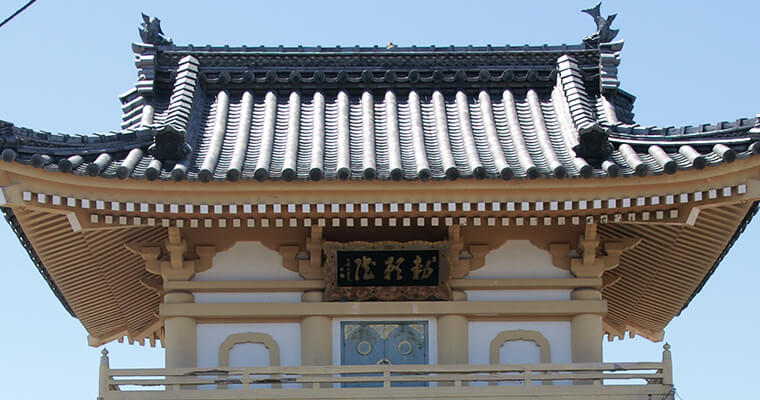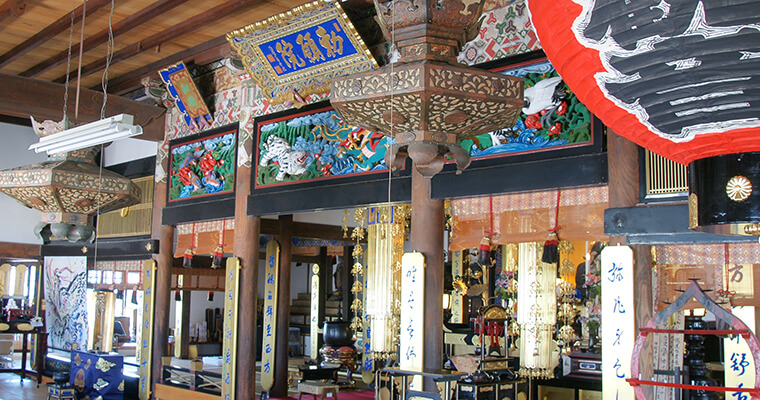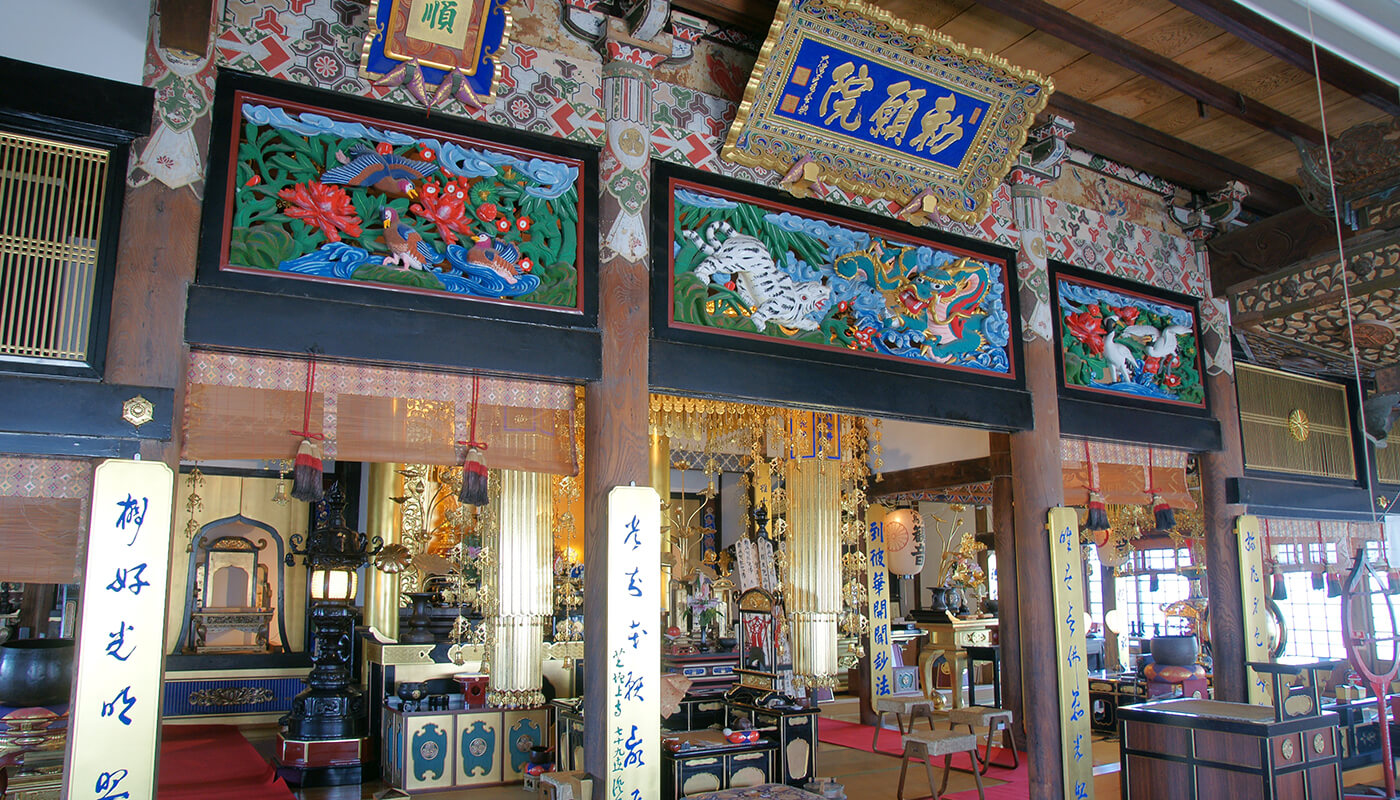Number 25Chokugan-in Kannon-ji temple
History of the temple
The history of this temple starts year 727, with miraculous arrival of Goddess Kannon at the Ono harbor (currently a part of Ōhama district). Kannon reveled herself as Nyoirin Kannon (Omnipotent Kannon) sitting on a mystical bird with four legs and eight heads. When Emperor Shōmu (701-756) learned about this miracle in 737, he decided to build a hall at Mount Tōjō to enshrine her and named it Fudarakuzan Kannon-ji (Kannon temple at sacred Mount Potalaka).
The temple was expanded to complete seven-structured compound in 864 by the 3rd Head of the Tendai sect of Buddhism – monk Enchin (814-891). After his visit the temple was officially acknowledged as one of 72 practice grounds that pray for safety of the Country.
In 1248 the 3rd Head of the Jōdo sect of Buddhism Ryōchū (1199-1287) visited Kannon-ji on his way to the eastern parts of Japan. He made the temple a Main Temple of Ise province which role was to teach the prayer to Buddha Amida (Buddha of Infinite Light). Ryōchū converted four elders of the nearby village to Jōdō sect and gave them Buddhist names. They were: Kanami (the founder of Hacchō clan), Dōami (founder of Shimizu clan), Senami (founder of Hinaga Ryōshō-ji temple), Yoami (founder of Tabika Kuhon-ji temple and Kuwana Jūnen-ji temple). The wooden statue of Ryōchū, which according to the legend was made by him, is enshrined in the Chokuganin Kannon-ji and is designated as Jōdō sect’s treasure. The prayer, which he taught in the temple, was also passed down through generations of monks for more than 700 years. Every year for three days during Obon (Festival of the Dead) the prayer is chanted in front of the statue of Ryōchū.
The temple moved to the current place originally called Rokuromi village in 1522 after the abbot saw Goddess Kannon in a dream two nights in a row. The name of the village probably comes from a word rokuro, which means lathe – a machine used to rotate wood while shaping and cutting. It is believed that the Japanese technique using lathe to create wooden bowls was created and promoted by Prince Koretaka (844-897), a half-brother of Emperor Seiwa (850-881). Woodturners (kijiya) that were using this technique probably came to this land from Watarai area and started to live at the bottom of Mount Suzuka.
On the 19th of December 1543 by the Emperor’s command the temple became an official praying place for Emperor Gonara (1497-1557). It was also presented with 6.93ha (17.12ac) of land. The official document written by Emperor Gonara was treasured by the monks for generations and it is still in the temple’s possession. The next two emperors: Emperor Ogimachi (1517-1593) and Emperor Goyōzei (1571-1617) also treated this place as their praying place. On the 2nd day of the New Year 600 scrolls of Great Perfection of Wisdom Sutra were chanted in the name of the Emperor, wishing for his long and healthy life and praying for stability of the Country. Chokugan-in Kannon-ji also sent tea, which was grown in its precinct, to the Imperial Palace.
In 1594 as a result of nationwide land survey ordered by the second “Great Unifier” of Japan Toyotomi Hideyoshi (1537-1598), the temple’s land was confiscated. It started to fall into decay but when the third “Great Unifier” of Japan and founder of 250 years lasting Togukawa shogunate shogun Tokugawa Ieyasu (1543-1616) learned that Chokugan-in Kannon-ji was a former Imperial praying place, he donated 1.9ha (4.6ac) of land on the 15th of February 1605. The temple was also officially given a rank of the Main Jōdō Temple in the province and was allowed to use the “triple hollyhock” crest of Tokugawa clan. Since then abbots of Chokugan-in Kannon-ji would visit Edo Castle on the 2nd of January every year and present the temple’s tea to the shogun. At the same time 600 scrolls of Great Perfection of Wisdom Sutra would be chanted at the temple wishing for peace and tranquility in the Country. Since then Tokugawa clan devoted themselves to Goddess Kannon worshiped at this temple. In 1699 Keishōin, a concubine of the 3rd shogun Tokugawa Iemitsu (1604-1651), donated an ornamental curtain displayed at the front of the main statue. In 1751 Takehime, adopted daughter of 5th shogun Tokugawa Tsunayoshi (1646-1709), donated a decorative cord with imprinted crest of Tokugawa clan. She also had a private small Buddhist statue made as a miniature of the Kannon statue enshrined in Chokugan-in Kannon-ji.
During the Edo period (1603-1868) numerous virtuous monks, among them in 1724 a monk named Kantsū, visited the temple’s grounds to spread the Buddhist teachings. In 1768 a member of Iwashimizu clan, a supporter of Chokugan-in Kannon-ji and a priest at Iwashimizu Hachimangū shrine founded the Main Gate of the temple. The Gate was build according to Kantsū’s teachings in a ryūgū style (dragon palace style). Unfortunately it was destroyed during the Tōnankai earthquake in 1944, but in March 1961 it was rebuilt.
The current bell of the temple was made in August of 1644. Luckily it was not confiscated as obligatory metal supply during the 2nd World War. The Main Hall which stands to this day was built in May of 1665 and later improved in 1751. In 1994 it was repaired thanks to cooperation of many believers and their enormous donation of 160.000.000 yen.
Seiyōzakki
Fudarakuzan Kannon-ji is located Rokuromi area of Hinaga village. It was started by Ryōchū, a son of Enjitsu, who was a grandson of Chancellor Minamoto Yorisada – an 8th generation descendant of Mido Fujiwara clan. In the past the temple had a 70 kan of land but it was taken away by bandits. The monks complained to the Imperial Palace and thanks to the councilor Kanjūji Harutyo the Emperor sent Oda Nobunaga to reclaim the lost property. After the death of Oda Nobunaga the land was lost again. After Tokugawa Ieyasu became a shogun, with a help of some people the monks complained to him about the ruined temple. The temple received 20 koku of land as a donation.

Outline
-
Honorific name
Fudarakuzan
-
Temple's name
Kannon-ji
-
Sect
Jōdo
-
Religious service
Nyoirin Kannon
(Omnipotent Kannon)





